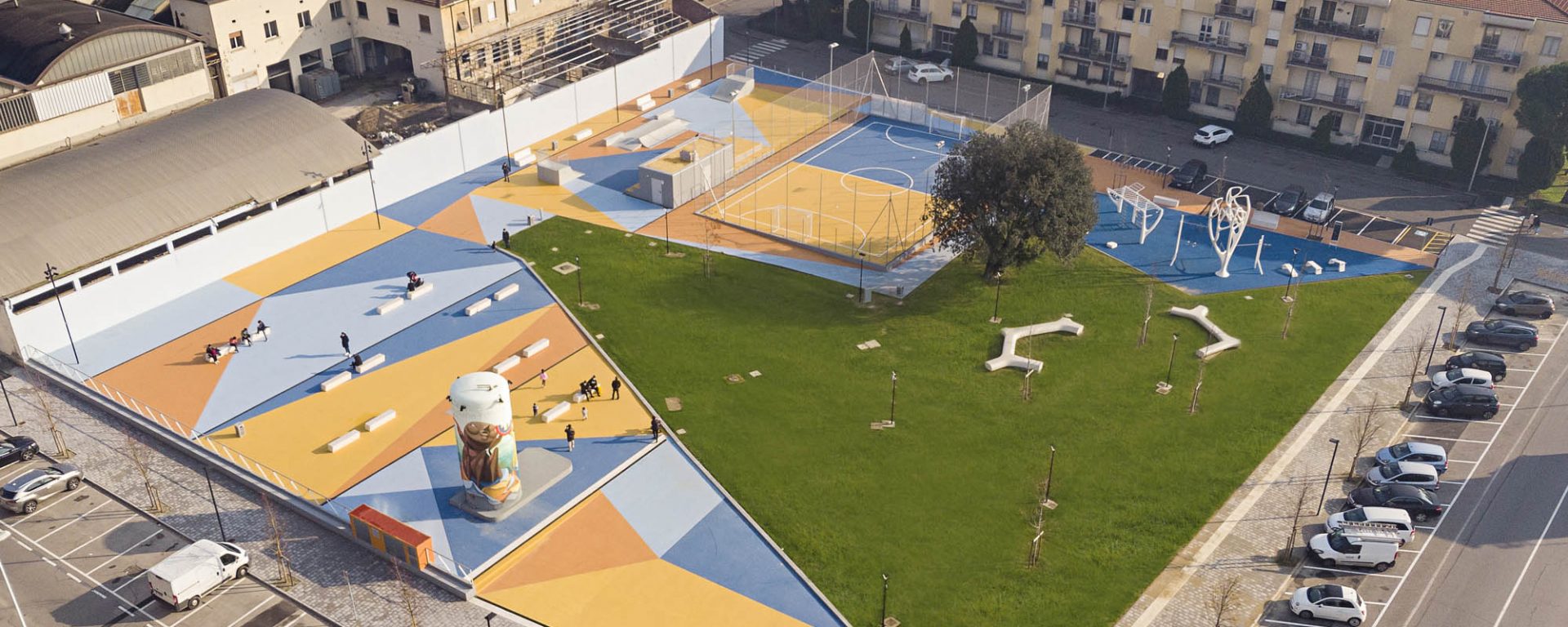普拉托MacroLotto Zero游乐场是 “P.I.U.普拉托 “这一更广泛的城市更新项目中计划的主要再利用干预措施之一,涉及Macrolotto Zero地区,一个 “工厂城市 “的城市结构,一个被高度利用为住宅和生产目的的区域,没有公共空间或服务。
The Playground MacroLotto Zero Prato is one of the main reuse interventions planned in the broader urban regeneration project “P.I.U. Prato”, involving the area of Macrolotto Zero, a “factory-city” urban fabric, a territory highly exploited for residential and productive purposes, with no public spaces or services.
自从城市的生产系统开始走下坡路以来,该地区见证了市民和企业的逐渐放弃,同时也见证了华人社区的定居,他们在该地区的功能组合中找到了生活和工作的最佳条件。由欧洲共同体和普拉托市政府资助的 “P.I.U.普拉托 “项目,通过实施城市和社会再生政策,将Macrolotto Zero地区改造成一个社会和经济上活跃的地区,通过一系列的行动,聚焦于同一个共同点,即公共空间。
Since the city’s production system began to undergo a decreasing path, the neighbourhood has witnessed the progressive abandonment by its citizens and businesses and the simultaneous settlement of the Chinese community, which has found in the area’s functional mix, the optimal conditions to live and work. The “P.I.U. Prato” project, financed by the European Community and the Municipality of Prato, set the goal of redeveloping the area of Macrolotto Zero by implementing urban and social regeneration policies, transforming it into a socially and economically lively area, through a series of operations focusing on the same common denominator, the public space.
该项目包括恢复前工业建筑,并对其进行重新功能化,以举办新的社会和文化活动–如媒体图书馆、协同工作空间和大都会市场–室外区域和绿色空间的再生以及可持续交通的干预。游乐场是整个项目中最大的公共空间,建在一个以前被用作非法停车场和废弃工业综合体的储存区的地方。该地区本身代表了一个独特的机会,尽管它缺乏特色,除了储水筒仓,该空间代表了一个更广泛的城市再开发的战略枢纽,此外它还与该地区正在进行的新的公共空间系统相连接。
The project included the recovery of ex-industrial buildings and their re-functionalization to host new social and cultural activities – such as a Medialibrary, a Coworking space and a Metropolitan Market – the regeneration of outdoor areas and green spaces and interventions of sustainable mobility. The Playground is the largest public space in the whole project, built on a place previously used as an illegal car parking and storage area for the abandoned industrial complex. The area itself represented a unique opportunity, despite its lack of features, except for the water storage silo, the space represents a strategic hub for a wider urban redevelopment in addition to its connections with the new public spaces system in progress in the area.
该项目包括将再利用的方法与尊重该地区的综合结构和复杂的本质相结合,将现有的环境和平面特征和限制转化为资源,目的是将一个匿名和孤立的空间转化为一个新的城市地标,在其艺术和建筑特征上具有统一的可识别性,能够激发人们的社区和归属感,创造一个社会聚集和自由表达的地方。整个广场的特点是强烈的色彩存在,为每个功能区划分为不同的部分,为铺装的表面提供活力和特色。视觉分区的目的是与相邻的绿色花园区形成对比,从而实现两个不同的综合功能子系统,能够相互促进,并发挥其差异和潜力。
The project consisted of combining a reuse approach with a respect towards the area’s consolidated structure and complex essence, transforming the existing environmental and planimetric features and limits into resources, with the goal of converting an anonymous and isolated space into a new urban landmark, univocally recognizable in its artistic and architectural traits, able to stimulate a sense of community and belonging in the population, creating a place of social aggregation and free expression. The whole square is characterized by a strong presence of colours, divided into segments for each functional area, providing dynamism and character to the paved surface. The visual zoning aims to create a contrast with the adjacent green garden areas, and so implementing two different integrated functional sub-systems, able to enhance each other and their differences and potentials.
该地区特有的颜色也成为Zed1创作的新艺术作品的艺术成分,Zed1是一位著名的街头艺术家,他在筒仓的表面进行了干预,这让人想起该地区和城市的多民族性,发出了团结一致面对未来的信息。
The area’s characteristic colors also become the artistic component in the new artwork created by Zed1, a well-known street artist who intervened on the surface of the silo, that recalls the multi-ethnicity of the neighborhood and the city, sending a message of solidarity and unity to face the future.
该地区向公众开放后,对预期的改造有了重要的反馈。各年龄段用户的高出席率和满意度表明,该项目已经实现了市政府在最初规划阶段设定的城市和社会重建目标。
The opening of the area to the public gave important feedback regarding the expected transformation. The high rate of attendance and satisfaction among the users in the various age groups points out that the project has achieved the urban and social redevelopment objectives set by the Municipality during the initial planning stage.
Architects: Ufficio Planificazione degli Spazi Pubblici del Comune di Prato
Year: 2020
Photographs: Emma Neri
Manufacturers: Mapei, Thorn, Cariboni, Euroform W, Guzzini, METALCO, My Equilibria
Lead Architects: Arch. Michela Brachi, Arch. Massimo Fabbri, Ing. Alessandro Pazzagli.
City:Prato
Country:Italy

